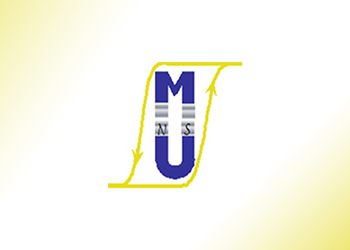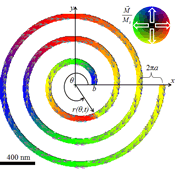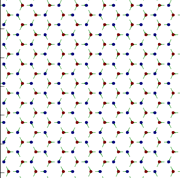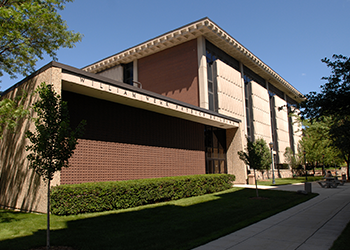Micromagnetics Research Lab
About the lab
|
Office Location & Contact
Wehr Physics Building, 301
(414) 288-3031
andrew.kunz@marquette.edu
|
- NSF-DMR 1309094 (2013 - 2016)
- NSF-DMR 1006947 (2010 - 2013)
- NSF-DMR 0706194 (2007 - 2010)
- Research Corporation (2007 - 2009)
|
 Ferromagnetic materials (like iron) can have a spontaneous magnetization even in the absence of any externally applied magnetic field. This property is useful for a wide variety of applications, but it is particularly useful in the area of data storage because the magnetization has two values for any given field. (This behavior is demonstrated in the hysteresis loop shown to the left).
Ferromagnetic materials (like iron) can have a spontaneous magnetization even in the absence of any externally applied magnetic field. This property is useful for a wide variety of applications, but it is particularly useful in the area of data storage because the magnetization has two values for any given field. (This behavior is demonstrated in the hysteresis loop shown to the left).
Since the first magnetic hard drives were built the areal density of magnetic bits has been doubling at a rate of about every other year. This is accomplished primarily by reducing the amount of magnetic material necessary to store information. This process can not continue indefinitely, therefore other data storage techniques are necessary.
Nanowires made out of ferromagnetic materials are a potential solution. The wire geometry is advantageous because a wire is not necessarily confined to the surface of a disk; spatial constraints are no longer an issue.
Additionally, we have learned that it is possible to move information rapidly along the nanowire with weak magnetic fields; leading to devices that could operate significantly faster than currently available.
Here in the Physics Department at Marquette University my undergraduate students and I use computer simulation to model and understand high speed magnetization dynamics and to develop techniques to read and write information quickly and reliable. Computer simulation is useful because we need to work on a scale that has a spatial resolution of a few nanometers (1/1000 of the width of a hair) and on a time scale of 100's of picoseconds (10-12 s). Experimentally it is possible to explore the behavior with comparable spatial resolution, or with comparable time resolution, but techniques which have access to both simultaneously are lacking. Computer simulation has proven to be a valuable tool for both understanding high speed magnetization dynamics and for predicting behavior in new systems. We use the computer predicatively and develop the results to gain new understanding of the important processes involved.
Below is a description of some of the current areas of active research going on in my group. A list of publications follows, a majority of my undergraduate students are co-authors on these papers as they are in fact generating the bulk of the data.
Definitions
- Magnetic Domain - in the interior of a ferromagnetic material the microscopic magnetic moments tend to align in the same direction. A region where this occurs is called a magnetic domain.
- Domain Wall - domains form in random orientations. When two domains of differing magnetization meet a domain wall forms. In a nanowire device it is the domain wall that is responsible for storing and transmitting information.
 Spiral Nanowires for Sensor Applications: Some of the more recent work in my lab has been focused on domain wall motion in spiral nanowires. We use a rotating magnetic field to drive the domain wall through the wire and we find that the angular speed of the domain wall is essentially equal to that of the angular speed of the rotating field, over several decades of frequency range. The tracking of the domain wall with the field could lead to accurate rotary motion sensors. Scientifically these are interesting because of the curved geometry; domain wall speeds in the outer arms of the spiral greatly exceed the maximum value found in straight wires.
Spiral Nanowires for Sensor Applications: Some of the more recent work in my lab has been focused on domain wall motion in spiral nanowires. We use a rotating magnetic field to drive the domain wall through the wire and we find that the angular speed of the domain wall is essentially equal to that of the angular speed of the rotating field, over several decades of frequency range. The tracking of the domain wall with the field could lead to accurate rotary motion sensors. Scientifically these are interesting because of the curved geometry; domain wall speeds in the outer arms of the spiral greatly exceed the maximum value found in straight wires. Artificial Spin Ice: Another current research area is focused on artificial spin ice (ASI). ASI is a metamaterial which consists of a large array of identical magnetic islands. We have developed computational codes to study phase transitions and dynamics in ASI materials. We are currently focused on Kagome lattices which create a highly frustrated system. We are the first group to investigate disorder in these materials and we find interesting behavior in the entropy as we vary the amount and types of disorder. This behavior has been observed in physical spin ice systems and as such we can show how disorder is important in real systems. This is a rich thermodynamic system and fun for a physicist to study.
Artificial Spin Ice: Another current research area is focused on artificial spin ice (ASI). ASI is a metamaterial which consists of a large array of identical magnetic islands. We have developed computational codes to study phase transitions and dynamics in ASI materials. We are currently focused on Kagome lattices which create a highly frustrated system. We are the first group to investigate disorder in these materials and we find interesting behavior in the entropy as we vary the amount and types of disorder. This behavior has been observed in physical spin ice systems and as such we can show how disorder is important in real systems. This is a rich thermodynamic system and fun for a physicist to study.- Domain Wall Control: It is necessary to inject, move, store, and potentially reposition a domain wall in a nanowire quickly and reliably. This is our definition of control. In a planar nanowire, such as the ones we study, the domain wall moves quickest when driven by a weak magnetic field. We were the first to demonstrate an injection pad that allows for low field injection of not just one, but multiple domain walls (see ref. 8) into a single nanowire. Once the domain wall is in the wire, it is necessary to hold it there and the most common technique is via a notch inscribed in the wire. It is possible to select which notch to position a moving domain wall at with the application of a magnetic field component applied perpendicular to the wire. Ref. 5 below has a nice description and visualization of the control process.
- Nanowire Arrays: The majority of nanowire research has been conducted on individual nanowires, whereas devices are going to consist of many wires, each containing many domain walls. The ability to individually select, and controllably move one domain wall in such a system is critical. Recently (see ref. 1) we have demonstrated a technique to create a localized magnetic field that can be applied to select and move a predetermined domain wall. Improving the reliability of this process is a very active component of our current research efforts. A recently discovered feature actually increases the selectivity and viability of domain wall control, a discovery we are very excited about. More to come as we finish this development.
- Domain Wall Interactions: In both single wires and in nanowire arrays, the domain walls interact with each other. Knowledge of the interaction strength is important for understanding how closely the wires and the domain walls can be packed.
- Defects: All wires contain defects and it turns out that this can be a good thing. A current student, with support from the Wisconsin Space Grant Consortium (WSGC) has shown that lots of microscopic defects actually improve the speed of a moving domain wall especially when driven by strong magnetic fields where the motion is typically quite slow. We have worked to develop a simplified model of the interaction of a moving domain wall with the defects to explain the result. A lot of fundamental physics is applied to most easily and accurately describe the counter-intuitive behavior.
Publications at Marquette
(Denotes MU undergraduate student)
- 1. R. Schumm and A. Kunz, "Magnetization reversal in ferromagnetic spirals via domain wall motion," Applied Physics Letters 109, 202405 (2016).
- 2. A. Kunz, H.H. Le, D. Kutzke, J. Vogeler-Wunsch, "Selection and control of individual domain walls in nanowires via asymmetric depinning fields," IEEE Trans. Magn. 52(2), 1300205 (2016).
- 3. A. Kunz and J. Vogeler-Wunsch, “Application of local transverse field for domain wall control in ferromagnetic nanowire arrays,” Applied Physics Letters 101, 192402 (2012).
- 4. G. Burch, T. Shultz, A. Kunz and E.D. Dahlberg, “Magnetic Response vs. Lift Height of Thin Ferromagnetic Films,” IEEE Transactions on Magnetics 46 (6) 1752 - 54 (2010).
- 5. A. Kunz and E. Rentsch, “Simulations of Field Driven Domain Wall Interactions in Ferromagnetic Nanowires,” IEEE Transactions on Magnetics 46 (6) 1556 - 58 (2010)
- 6. A. Kunz and J. Priem, “Static and Dynamic Pinning Fields for Domain Walls in Ferromagnetic Nanowires,” IEEE Transactions on Magnetics 46 (6) 1559 - 61(2010).
- 7. A. Kunz, “Improved magnetic domain wall control with transverse fields”, SPIE Newsletter http://spie.org/x1004.xml, September 24, 2010.
- 8. A. Kunz, J.D. Priem, and S.C. Reiff, “Injecting, controlling, and storing magnetic domain walls in ferromagnetic nanowires,” in Spintronics III, edited by H.-J. M. Drouhin and J. –E. Wegrowe, M. Razeghi, Proceedings of SPIE Vol 7760 (SPIE, Bellingham, WA 2010), 776005.
- 9. A. Kunz, S.C. Reiff, J. D. Priem, and E.W. Rentsch, “Controlling individual domain walls in ferromagnetic nanowires for memory and sensor applications,” Conference Proceedings, IEEE Xplore (2010).
- 10. A. Kunz and S.C. Reiff, “Dependence of domain wall structure for low field injection into magnetic nanowires,” Applied Physics Letters 94, 192504 (2009).
- 11. A. Kunz, “Field induced domain wall collisions in thin magnetic nanowires,” Applied Physics Letters 94, 132502 (2009). See also Nature Physics Research Highlights (Nat. Phys. 5, 313 (2009)).
- 12. A. Kunz, E. C. Breitbach, and Andrew J. Smith, “Anti-vortex dynamics in magnetic nanostripes,” Journal of Applied Physics 105, 07D502 (2009).
- 13. A. Kunz and S. C. Reiff, “Fast domain wall motion in nanostripes with out-of-plane fields,” Applied Physics Letters 93, 082503 (2008).
- 14. A. Kunz and S. C. Reiff, “Enhancing domain wall speed in nanowires with transverse magnetic fields,” Journal of Applied Physics 103, 07D903 (2008).
- 15. A. Kunz, “Micromagnetics of the domain wall mobility in permalloy nanowires,” IEEE Transactions on. Magnetics 43 (6) 2944-46 (2007).
- 16. A. Kunz, “Simulating the maximum domain wall speed in a magnetic nanowire,” IEEE Transactions on Magnetics 42 (10) 3219 (2006).
- 17. A. Kunz, “Simulated domain wall dynamics in permalloy nanowires,” Journal of Applied Physics 99 08G107 (2006).


 Ferromagnetic materials (like iron) can have a spontaneous magnetization even in the absence of any externally applied magnetic field. This property is useful for a wide variety of applications, but it is particularly useful in the area of data storage because the magnetization has two values for any given field. (This behavior is demonstrated in the hysteresis loop shown to the left).
Ferromagnetic materials (like iron) can have a spontaneous magnetization even in the absence of any externally applied magnetic field. This property is useful for a wide variety of applications, but it is particularly useful in the area of data storage because the magnetization has two values for any given field. (This behavior is demonstrated in the hysteresis loop shown to the left). Spiral Nanowires for Sensor Applications:
Spiral Nanowires for Sensor Applications:  Artificial Spin Ice:
Artificial Spin Ice: